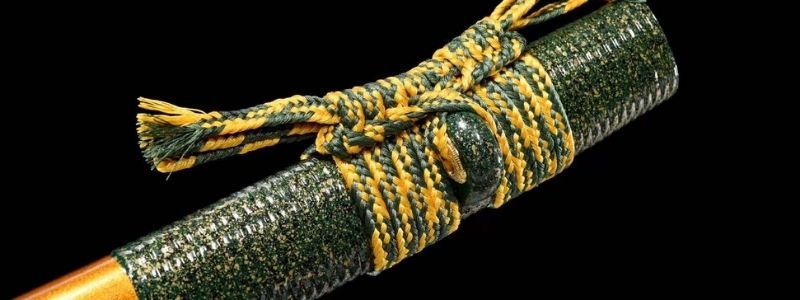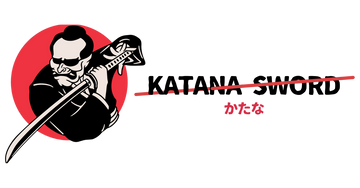Easy Katana Guide
Katana is very often misunderstood and brings a lot of confusion. There are many things to know and it is not easy to find your way around, especially with Japanese names.
So we have made an EASY GUIDE for you to understand everything in a few minutes...
1. Types of Katanas and use
There are several types of Katanas and it is important to know how to choose your sword according to your needs.
Edge
To perform Tameshigiri or training and demonstration cuts, you will need a Sharp Katana. You will be able to practice the art of cutting from rolled Omoto Tatami or bamboo.
This cutting allows you to test your katana, but it is also a real physical and mental training to make the cut in the perfect angle.
You can sharpen your katana yourself with a special stone, or send your katana to specialists to do it for you to avoid damage.
Unsharpened
The katana can also be delivered unsharp, but this does not mean it is of poor quality. Indeed, in martial arts, for example, it is forbidden to have a sharp sword, which is why one usually buys an Iaito (a lighter, non-sharp sword).
But you can also opt for a non-sharp Katana and sharpen it yourself or not sharpen it in order to leave it as a decoration.
For decoration
Most of the time the Katana is bought for decoration, because buying Tatami can be expensive and not everyone can invest so much money, and it is an excellent decoration that reminds the Japanese culture.
Who says decorative Katana does not say low-end Katana. You will find out in the following article, but the Katana is full of many details and knowing these details will totally change your experience with your Katana.
Having a beautiful high-end Katana in your home is therefore a totally understandable and very interesting choice, especially if you have friends as passionate as you are about Japan and its history.
2. Type of Katana Forge
There are different types of Katana forge and this is one of the most important features. By the way, don't confuse steels and forges which are two different things.
>> See how to choose your steel
Maru
The Maru Forge is a forge that makes up a single Steel. It is generally used for entry-level Katanas, but it is also possible to have a high-end Katana with this type of forge.
Indeed, everything will depend on the steel. A Maru forge with Hamon steel can be of very high quality and will offer a very strong and sharp edge.
Composite Blades
Then there are composite blades, which are blades that are made of different steels and layers. For example: Kobuse, Honsanmai, Sanmai, Gomai, Shihozume and many more...
These types of forging often correspond to an era of Japan and the evolution of the Katana, but they are all used. For a composite blade katana you will have to invest more than 500 $, prices can go up to several thousands of dollars.
3. Quality and type of steel
The best known steel is Tamahagane steel. To have a Katana with this steel, you will have to invest in 1500 $ minimum and wait several months up to more than one year.
The production and export of this steel is very limited in Japan, which makes the costs rise impressively. This steel is still a must with the alternate layer forging and multiple bending.
Alternative steels
Often people associate "TRUE KATANA" with a Katana made of Tamahagane steel costing several thousand Euros, but this is a stereotype.
As we have seen, it is quite possible to get a very high quality Katana that respects the traditions and the making of the Katana for a few hundred Euros. Few people can afford to spend 2000, 5000 or even 10 000€ on a Katana.
There are many different steels available, such as 1095, T10, Damascus, and many others that can be forged in traditional techniques with Hamon and all the details of the Katana.
4. Hamon

The Hamon is a wavy line that runs along the entire length of the blade's edge. This Hamon line is obtained after tempering, which is intended to harden the blade and make it very sharp. This is a very important characteristic that greatly influences the quality of the Katana and that many enthusiasts are looking for.
The Japanese have developed a technique: they cover the blade with a mixture of fire clay powder and silica, with other elements that each smith keeps secret.
This way, during the tempering process, the cutting part of the blade will not be cooled at the same speed as the rest of the blade and allows to have a harder and a softer part of the blade.
There are several types of Hamon, but it often depends on the blacksmith. You will find this natural line only on the higher end Katanas.
5. Blood tank(Bo-Hi)

The BO-HI of the katana which is a hole in the length of the blade allows several things. It makes the blade lighter, helps drain blood (historically) and also has an aesthetic function.
This feature is obviously for aesthetic purposes in this day and age, but it also provides a rather satisfying sound when you slice through the wind with your Katana.
6. Tsuba

The Tsuba is a real work of art. It is the guard of the Japanese katana, and its function is to protect, aesthetize, and balance the katana.
- Protection: it prevents the enemy from cutting the Samurai's hand by sliding his blade along the opponent's Katana.
- Aesthetics : a Tsuba is hand carved with traditional Japanese motifs like Sakura, demons or Japanese legends and it is really beautiful.
- Balance: with a heavy Tsuba you will have a balance rather centered on the Tsuba and thus towards the center of your Katana while with a light Tsuba the balance will be more towards the tip of your Katana.
7. Tsuka

The Tsuka is located under the Tsuka-Ito (the braiding of the handle). It is made of shark or ray skin. The hunting being regulated and sometimes frowned upon it is possible to have a Vegan Tsuka.
Function: To keep the Tsuka-Ito in its place and to reinforce the handle. It is a material which offers an ultra solid and pleasant holding.
8. Tsuka-Ito

The Tsuka-Ito is the braid placed just above the Tsuka. It is possible to find it in several colors, and it is a part of the Katana that makes it unique.
Function: Adherence and maintenance of the structure. It is also a good way to recognize a real Katana from a fake one. A good Tsukaito is solid and is braided very firmly so that it does not move.
It feels good to the touch and also absorbs perspiration.
9. Fuchi and Kashira

The Fuchi is a ring that is between the Tsuka and the Tsuba. It strengthens the Tsuka, it is also a unique decorative element.
The Kashira is the small tip placed at the very bottom of the Katana (end of the Tsuka). Its purpose is to reinforce the handle, but also has an aesthetic purpose. These small parts are made in detail and it is this kind of detail that we appreciate on the Katana.
10. Menuki

Menuki are a unique feature of the Katana. They are tiny ornaments in different shapes as in a traditional Japanese dragon or lion shape.
In addition to allowing a better attachment of the Tsuka-Ito to the Tsuka it also allows to emphasize that instead of the Mekugi (small piece of wood in the ray skin).
11. Sayanuri

Sayanuri is used to protect the Magnolia wood of the Saya (scabbard). The lacquering done on the scabbard is not really important and it is more for aesthetic purposes and anti-scratch.
12. Sageo

The Sageo is a braid that this time is not on the handle, but on the scabbard. It allows you to hang the Katana on your obi belt and offers a unique aesthetic. We advise you to match the color of your Sageo to your Tsuka-Ito to avoid too much fantasy.
These weaving fabrics are very original and can be made by craftsmen in Japan or in France.
13. Seppa and Habaki

Habaki : It is a metal piece that surrounds the base of the blade. This piece is meant to block the position of the Tsuba guard and to maintain the sword in its Saya scabbard with an adapted width. They are also aesthetic pieces that can be very expensive depending on the materials and the difficulty of the crafting.
Seppa : These are oval washers which allow to tighten the Tsuba guard. It is necessary to place a seppa on each side of the Tsuba guard.
14. Saya

This is the scabbard of the Katana. This scabbard is usually made of light wood lacquered on the outside. Often magnolia wood is used as a material. On this scabbard there is often the Sageo (braiding on the scabbard) which allows the Katana to be hung from the belt.
This is a very visible part of the katana, and is very much worked on by the craftsmen. It can be differentiated by several colors, patterns or even materials.
